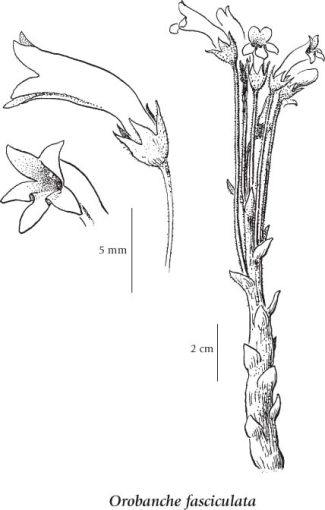Aphyllon fasciculatum
clustered broomrape
Orobanchaceae (Broom-rape family)
Introduction to Vascular Plants
clustered broomrape
Orobanchaceae (Broom-rape family)
Introduction to Vascular Plants
Species Information
General:
Parasitic herb from a coarse, tuber-like, fleshy root; stems single or clustered, short glandular-hairy, yellowish to purplish, 3-20 cm tall.
Leaves:
Basal leaves lacking; stem leaves scaly-bracteate, alternate, short glandular-hairy.
Flowers:
Inflorescence of loose flat-topped, several to many-flowered clusters; corollas yellow to purple-tinged, 1.5-3 cm long, the lips 4-9 mm long, stalked, the leafless stalks 2-15 cm long; calyces 9-11 mm long, the lobes 3-7 mm long, narrow, acute, equaling or slightly shorter than the tubes; anthers smooth or hairy.
Fruits:
Capsules; seeds numerous, angled, net-veined, less than 0.7 mm long.
Illustration

If more than one illustration is available for a species (e.g., separate illustrations were provided for two subspecies) then links to the separate images will be provided below. Note that individual subspecies or varietal illustrations are not always available.
Illustration Source: The Illustrated Flora of British Columbia
Ecology
Ecological Framework for Aphyllon fasciculatum
The table below shows the species-specific information calculated from
original data (BEC database) provided by the BC Ministry of Forests and Range.
(Updated August, 2013)
The table below shows the species-specific information calculated from
original data (BEC database) provided by the BC Ministry of Forests and Range.
(Updated August, 2013)
| Site Information |
Value / Class |
||
|
Avg |
Min |
Max |
|
| Elevation
(metres) |
974 | 190 | 2013 |
| Slope
Gradient (%) |
35 | 0 | 110 |
|
Aspect (degrees) |
181 | 30 | 345 |
| Soil
Moisture Regime (SMR) [0 - very xeric; 4 - mesic; 8 - hydric] |
2 | 0 | 6 |
| Modal
Nutrient Regime
Class |
C | ||
| #
of field plots species was recorded in: |
54 | ||
| Modal
BEC Zone Class |
IDF | ||
|
All BEC Zones (# of stations/zone) species was recorded in |
AT(3), BG(16), BWBS(2), CWH(1), ESSF(2), ICH(1), IDF(19), MS(1), PP(1) | ||
|
Source:
Klinkenberg 2013
|
|||
Habitat and Range
Parasitic, mainly on Artemisia in dry shrublands in the steppe and lower montane zones; frequent in SC BC; rare northward and eastward; N to YT, E to ON, S to IN, MI, CA and N MX.Status Information
Synonyms
Synonyms and Alternate Names:
Orobanche fasciculata Nutt.